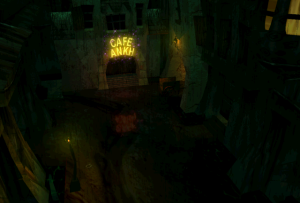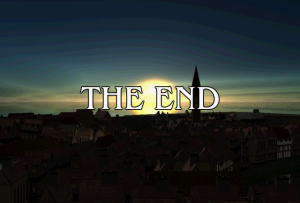So NihAV finally got Discworld Noir BMV support and I’ve tested it on all samples from the game to see if it works correctly. Here’s a sample frame:

(I still remember the song Samael plays there and have it somewhere ripped in its full MPEG audio layer II glory).
Now I want to talk about the format since it’s quite different from anything else. BMV used in Discworld II was simple but with two quirks: it employed integer coding using variable amount of nibbles (that were read as bytes but a nibble could be saved and used later) and it could decode frame either from the beginning to end or from end to beginning (reading frame data from the end too!). DW3 BMV is even stranger and let’s start with audio part. Audio codec is very simple: you have 41-byte block with one byte signalling which quantised values tables should be used for both channels and 32 indices for each channel packed into 16-bit words. The main peculiarity is that data is aligned to 16-bit and mode byte can be either in the beginning or at the end of the block. That’s a bit unusual but not strange. Well, it turns out it aligns for the absolute position in a file so my demuxer has to signal whether audio data was at even or odd position. And video is even stranger.
As I wrote previously, video codec is 16-bit now and still employs nibble variable integer coding and copy/repeat/new pixels mode. Luckily there is no backwards decoding mode yet the codec is tricky without it. First of all, where previously there were just three plain modes now we have combinations of those with bytes or nibbles signalling what should be done (i.e. copy/repeat/put new pixels fixed amount of times and then do the other operation another fixed amount of times). And they have different meaning depending on what was the last operation (copy/repeat/put for fixed amount or with arbitrary large one). And if there’s a nibble left unread after last operation or not. But that’s not all! While previously reading new pixels meant just reading a byte, 16-bit pixels can be compressed a bit more. In result we read 1-3 bytes per pixel: first read index byte, remap it, if it’s in range 00..F7 then return pixel in an array, if it’s in range F8..FE then read another byte and use it as an index in one of seven secondary “palettes”; if it’s FF then simply read explicit 2-byte value from the stream. The reference simply used an array pointing to the various functions performing this. And of course palettes can be updated in the beginning of each frame.
Surprisingly, decoder implementation takes about 28kB with a quarter of it being tables. That’s for both audio and video decoder. This is on par with other game decoders (GDV, Smacker and VMD) and feels significantly smaller than the reference (which is about 30kB in a stripped assembled .o file and over 200kB as assembly).
Overall it was hard to comprehend and tricky to debug too. Nevertheless now it’s over and I can probably move to TrueMotion 2X. Or whatever I decide to do when I’m bored enough.

well, that’s quite impressive to say the least